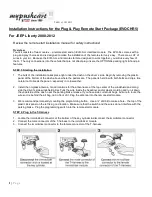
5 |
P a g e
Installer’s Tips
Tip #1 – Programming Options
There are a variety of useful programming options available for your remote starters such as “engine run time”, “idle down
timer”, etc. Instructions for how to program these options can be found on pages 15-16 of the installation instructions
manual for your LCPRO remote start. Descriptions for each of the options available can be found on pages 17-21.
Tip #2 – Where Everything Goes
There are 4 parts to your system:
1.
Remote start module
– the wiring for the module is done under the dash on the driver’s side, so you’ll want to
install the module in that general area. Before you start wiring, look for a location where there’s some open
space that will fit the module. Pay attention to moving parts like the pedals, e-brake and steering column. Be
sure to route your wiring away from those areas.
2.
Bypass module
– can be stowed along with the remote start.
3.
Valet Switch
– Requires a small screw hole. Usually put in the driver’s kick panel (that’s the area forward of the
door), the driver’s side of the center console, or the underside of the dash.
4.
Hood Pin Switch
– An important safety component! Requires a 3/8” hole. Find a location in the engine
compartment to mount the switch where the closed hood will keep the plunger in the switch depressed. This is
what prevents the car from starting when the hood is open.
Tip #3 – How to make your wiring connections
It’s very important that all your wiring connections be solid and secure. All remote start connections are “tap on”
connections. This means that you do not need to cut the wires in the car. You simply need to “tap on” to the wires in the
car to make your connections. Here are three different ways to do this:
Method 1 – Solder and tape
This is the method preferred by the best professional installers. It makes for the most reliable connections, but it is also
the most difficult to do. Sometimes there isn’t enough room in the wiring harness to safely solder a wire without
damaging adjacent wires, but if you have the soldering skills, go for it. To make a connection, strip back a section of the
insulation on the wire in the car. On heavy gauge wires, 1” is about the right amount. On lighter gauge wires, ½” is fine.
Strip 1” of insulation off the end of the remote start wire. Tin the bare section of wire in the car. Wrap the remote start
wire around the tinned section and then carefully solder it in place. Wrap the splice tightly with electrical tape.
Method 2 – Wrap and tape
This is the most popular method and is also very reliable. Strip back a section of the insulation on the wire in the car. On
heavy gauge wires, 1” is about the right amount. On lighter gauge wires, ½” is fine. Strip 1” of insulation off the end of
the remote start wire. Separate the strands of the wire like this:
Pass the wire from the remote through the opening as shown below
Wrap the remote start wire around both sides of the car wire, then back around itself as shown below
Содержание 2008 Liberty
Страница 3: ...3 P a g e...
























